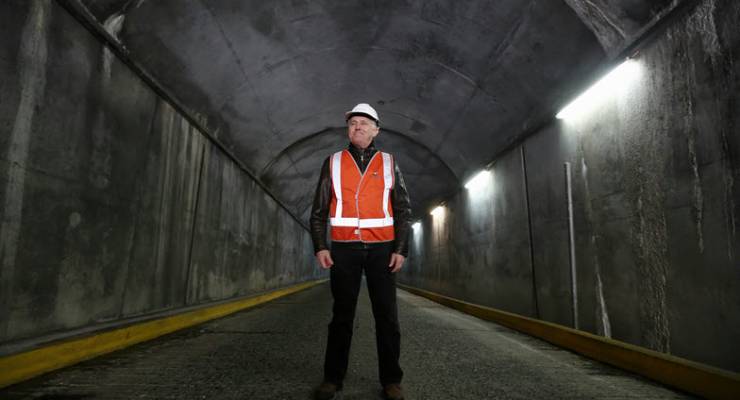
Amidst all the noise over the largely-ridiculed National Energy Guarantee (NEG), cuts to Australia’s marine parks, and a questionable grant for the resources-backed Great Barrier Reef Foundation, Prime Minister Malcolm Turnbull can count the Snowy Hydro 2.0 expansion as possibly this government’s singular achievement in environmental policy.
Announced in March last year, the plan to add 2GW of pump storage to the 4.1GW Snowy Mountains Scheme was, relatively speaking, embraced by politics left and right. Snowy 2.0 has been seen as something of a pet project for the PM, who bought the Victorian and NSW government shares in March and has a long-held admiration for hydropower.
Part of why Turnbull has been able to market Snowy Hydro 2.0 so successfully is because the project demonstrates a genuine contribution to Australia’s electricity grid without outwardly threatening the right’s love affair with coal-powered generation. Even though the expansion also includes a tender for 800MW renewable generation, that’s dwarfed by an extra 2000MW/350,0000MW hours of pumped hydro. And while storage has become synonymous with a renewable future, the process works regardless of sourcing.
“We know that NSW has a very low proportion of renewable energy at the moment,” Climate Council researcher Petra Stock tells Crikey, with 2016 figures putting renewables at 20%. “So if Snowy Hydro 2.0 is accompanied by a dramatic increase in investment in renewable energy, then it could potentially be good for reducing emissions, but, if nothing much changes in NSW and there isn’t that dramatic increase, then the project could actually be worse.”
There’s also the fact that all storage loses some power in the process: Snowy Hydro sits at 75%, so for every 100MW hours pumped up hill it will deliver 75MW hours of energy. In the words of Utopia’s Rob Sitch, the grid as it stands means that “pumped hydro is like trying to charge a Tesla with a diesel generator”.
But Snowy Hydro’s CEO Paul Broad is adamant that the project’s large-scale storage and dispatchable generation will reduce emissions by “firming” intermittent solar and wind generation across the the National Electricity Market (NEM) and help financially underpin new renewable projects.
“The key point here is that Snowy 2.0 will use the peaks and troughs in the market to ‘time shift’ energy, pumping at times of low demand, using surplus energy, and generating at times of high demand when supply is tight,” Broad tells Crikey. “By the mid-2020s when Snowy 2.0 operational, it is expected that most of the surplus energy will come from intermittent renewable sources.”
Still, while Snowy will be able to contract when and where it purchases energy when it launches in 2024, fossil fuels could still hold a sizeable chunk of the NEM. Even the Australian Energy Market Operator’s more ambitious forecast has renewables at just under 60% by 2030 (although, in notable news, 100% in South Australia by 2025). This is all before you even consider the NEG’s (widely-slammed) prediction for 36% on the NEM by 2030.
Further, a report from Marsden Jacob found that Snowy 2.0 would actually “improve the economics of coal-fired generation” by establishing “firming” capacity across the NEM. Basically, if renewables can be switched on and off but coal plants can’t, Snowy will be there to take whatever coal power would get displaced.
In fairness, the company has said it has no interest in underpinning coal, and Broad argues that if Snowy 2.0 was not built the likely alternative — “batteries paired with gas peaking plants” — would run at twice the cost and even higher emissions. He points to an apparent 60GWh deficit in South Australia’s wind generation from 2015-16 as an example.
“Assuming a 100MW battery was fully charged at 0.129GWh, it would be only be able to cover 0.2%, or a few hours, of this two-week energy deficit. Snowy 2.0, however, could generate energy to fill the gaps throughout the two-week period without needing to recharge.”
On that point, critics have compared the project to a war on batteries, and pointed to comments from Broad describing demand-management as “enforced blackouts” as a sign the project hinders a more sophisticated maturation of the grid.
Pumped hydro and batteries are obviously not exclusive, and even complementary in terms of long-term/short-term advantages. But, again, Australia already has a huge amount of storage projects being built; we could hit 50% renewables by 2030 without any more.
In a roundabout way, this all puts the pressure back on Turnbull, who is now both the chief policy maker, the owner of the fourth biggest “gen-tailer” (generator/retailer) in the country, and has also had to defend the ballooning costs of the roughly $6.5 billion project.
It sounds glib, but to justify that, Australia will need to be at a point in 2024 where “surplus energy” translates to “surplus renewable energy”.
Will Snowy Hydro be a victory or a failure for Turnbull’s legacy? Write to boss@crikey.com.au and let us know what you think.








Well since it wasn’t originally Turnbulls project or idea it may just succeed…but only if he has absolutely nothing to do with the implementation….everything he touches turns to shit.
Agree, or sold on to private/profiteers, socialise the costs, privatise the profits.
Tell ya what. We’ll let you know if, & when, it ever gets off the drawing board. As I understand it, the cost of implementation has already blown out from the original estimates. So my guess is NO!!
Coal power station $3-6 billion, 10 year build; nuclear power station $9 billion plus, 20 year build; large to massive running costs plus potentially enormous cleanup costs.
Upgrade Snowy $2-4 billion, up and running mid 20s, small running costs.
Show me *proof* that it will be done that cheaply, or that quickly.
All large project estimates tend to be ‘guesstimates’, but I think the time/cost ratios between the 3 scenarios above probably stands. That said, I think wind/solar should be rolled out all over the country, I also think residential solar/battery, using block chain (or similar) technology, could be utilised to supply baseload in just a few years.
Snowy Hydro is crap !!! The money could be spent so much better. !!
Oh do pray tell, Di.
There are several other viable renewable energy systems, but hydro, whether pumped or natural, is almost without peer as an energy source, which is why it’s been used all over the world so successfully for over 100 years.
Most of the world prefers to use Run of the River Hydro systems. Lower cost, both financially or environmentally. Still, can’t let facts get in the way of your sad little ideological rant.
In the not far distant past Snowy Hydro breached its legal contract to permit a specified amounts of water to flow down stream thus turning the mighty Snowy River into a putrid trickle. Drought has caused Snowy Hydro to not have sufficient water to feed the turbines, thus not a truly reliable source of energy. Building a Snowy Hydro 2 will not create a dependable electricity supply.
Reusing otherwise wasted water is the point of ‘pumped’ hydro, Marion.
“Otherwise wasted” on the wilderness downstream?
It was not wasted water that Snowy Hydro wasn’t letting flow to the downstream waterways – there wasn’t any water! Snowy Hydro had taken more than their contract allowed them to have but they still didn’t have enough water to pump back to release to activate the turbines.
To provide Snowy 2 with water it will have to be taken from other users, so who will lose their normal water supply so that Snowy 2 can store and pump it back and forth? Having another dam will not create water out of nothing.
Marion is quite correct. The original Snowy Scheme diverted the Snowy River inland and deprived the Snowy Valley ecology of its lifeblood water. Snowy Hydro 2.0 will lose water by evaporation from its upper and lower ponds. And any hydro is killed by drought. Don’t be intimidated into silence!
So making an announcement is counted as a success nowadays? Sounds like a very low bar to me?
Snowy Hydro 2.0 is worthy of a lot more praise than it gets. It is the largest amount of energy storage that Australia is likely to get for the foreseeable future. It can store enough energy to deliver 2.0 GW of power for 175 hours (on Chris’s figures), more than a week. For several decades, Australia’s existing pumped hydro of 2.5 GW has served to buffer excess supply of steam generation against variations of demand. Since then, Australia’s consumption and the amplitude of its variations have increased to swallow up Snowy Hydro 2.0.
Voices that decry pumped hydro as a means to store coal are missing the point. It is steam generation that is being stored, whether the boilers are fired by coal, gas or nuclear. Because steam is most efficient when run continuously at maximum, it benefits by being backed up by storage on the scale of Snowy Hydro 2.0. However, steam generation is anathema to the windmill salesmen, because it is too slow to respond as fast as the wind collapses. Wind generation needs single stage gas turbines to back it up. Expect more ridicule from the windmill salesmen!
Your lies are become ever more brazen there, Roger. From where I am sitting, it is Renewable energy that is anathema to those who continue to peddle late-19th century boiler technology onto the public, irrespective of the ever increasing cost. Whether it is stored or used immediately, generation of steam from burning of coal or the fission of uranium is actually a terribly wasteful process, with even the best designs losing over 40% of their total thermal capacity as waste heat. Fact is there are better ways of producing steam than by “burning” a finite fuel (which generates pollution), & there are better ways to generate electrons than by boiling water using mostly 19th century technology.
You are aware that the electrons used to push water uphill are exactly the same, whether they were generated from steam or generated from a wind turbine or a solar panel?